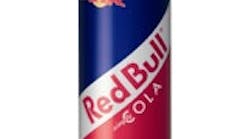Still, carbonated soft drinks remain the favorite beverage of Americans, who downed an average of 49.3 gallons of soda in 2007. But rising commodity costs pushed prices up 5 percent last year, perhaps helping to drive down consumption, which slid by 2.3 percent, according to Beverage Digest. That’s a faster decline than the 0.6 percent in 2006 and 0.2 percent in 2005, which collectively erased gains in soda sales made since 2000.
Coca-Cola (with 42.8 percent of the market) and Pepsi-Cola (31.1 percent market share) lost fizz as higher prices drove consumers to less expensive private label colas. Those who didn’t mind spending a little extra for their beverages preferred better-for-you choices, such as water and enhanced energy drinks.
U.S. annual per capita consumption of soft drinks remains the highest in the world, at 789 8-oz. servings last year, but declined from 849 8-oz. servings in 2000. North America is the biggest beverage market in the world.
Coca-Cola and PepsiCo's soft-drink volumes fell 2.7 percent each, and each company's share of the U.S. carbonated soft-drink market slipped 0.1 percentage point, reports The Wall Street Journal.
Among the Top 10 selling soda brands, only PepsiCo’s Diet Mountain Dew and Cadbury Schweppes’ (now Dr Pepper Snapple Group’s) Diet Dr Pepper posted volume growth. The top two brands, Coca-Cola Classic and Pepsi-Cola, continued to slide, with Coke volume down 3 percent and Pepsi dropping 4.8 percent.
Both companies have been rolling out variations on their main brands. Coke has mixed its namesake cola with cherry, lemon, lime and vanilla. Pepsi has done likewise, even creating the Diet Pepsi Jazz variation with such flavor combos as strawberries & cream, black cherry & French vanilla and caramel cream.
Company |
2007 Market Share |
Percent change from 2006 |
Coca-Cola |
42.8% |
-0.1% |
PepsiCo |
31.1 |
-0.1 |
Cadbury-Schweppes |
15.0 |
0.1 |
Cott |
4.8 |
-0.3 |
National Beverage |
2.5 |
0 |
Hansen Natural |
0.8 |
0.2 |
Red Bull |
0.6 |
0.1 |
Rockstar |
0.4 |
0.1 |
Big Red |
0.4 |
0 |
Private Label & Other |
1.6 |
0 |
|
Source: Beverage Digest, Wall Street Journal |
||
Ditto for alternative sweeteners. Volume of Coca-Cola Zero, a diet cola sweetened with acesulfame potassium and aspartame instead of just aspartame as in Diet Coke and Diet Pepsi, rose an astonishing 37.5 percent.
Both Coke and Pepsi are finding success in overseas markets, particularly China, where consumers have discovered the joys of cola. Meanwhile, there’s a new threat at home. Red Bull GmbH, the Austrian company that developed the bestselling energy drink, this month launches Red Bull Cola in seven countries, including the U.S. Its first brand extension, the “natural cola” contains cola nut, coca leaf and natural caffeine from coffee beans (32mg) and will be packaged in slim cans.
And in May, a new/old company was launched. Dr Pepper Snapple Group was demerged from Cadbury Schweppes PLC. Analysts and other observers will be watching how independence affects the company’s marketing (and sales) of such brands as Dr Pepper, RC Cola and 7-Up.
In terms of packaging, several U.S. soft-drink bottlers are testing alternatives to a convenience-store icon: the 20-oz. bottle, which once revitalized U.S. sales for Coke and Pepsi by offering a larger serving size. While U.S. soda sales in major retail channels overall declined 3.5 percent in the first quarter, convenience-store sales dropped 4.2 percent, according to Beverage Digest, and the 20-oz. bottle accounts for most convenience-store soda sales.


